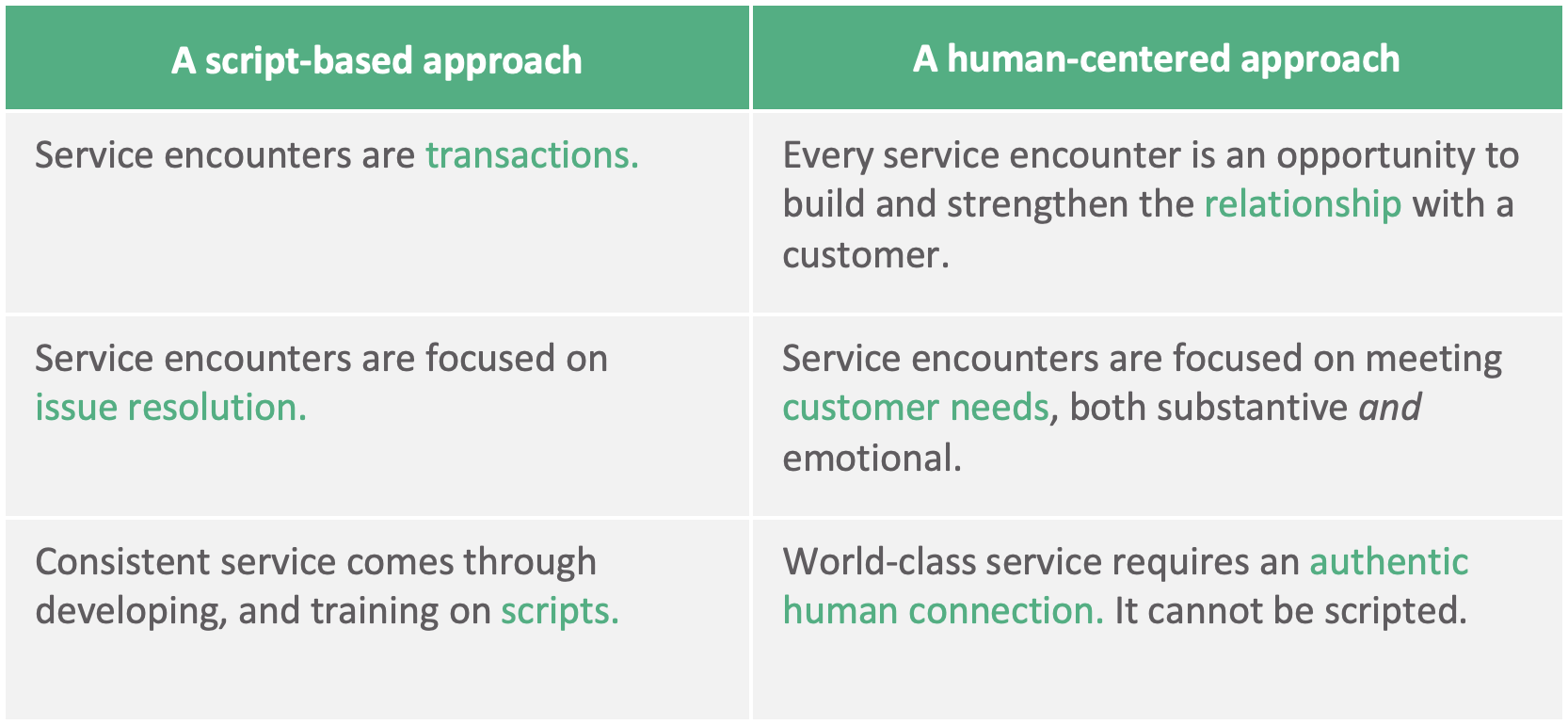California Management Review
California Management Review is a premier professional management journal for practitioners published at UC Berkeley Haas School of Business.
by Jonathan Hughes, Gabriella Salvatore, and Sara del Aguila

Image Credit | Joyce Busola
Call it human-centered customer service — a model that leverages the evolving capabilities of artificial intelligence working in concert with human agents who lead with the heart, not a script. For decades, companies in industries from healthcare to financial services have sought to bring control, consistency, and predictability to their customer service and support by training service representatives to follow rigid call scripts, and through technology-enabled automation. In healthcare, where encounters with patients (insurance companies usually refer to them as “members”) are often complex, high-stakes, and emotionally charged, companies increasingly employ AI alongside human agents, leveraging each for its inherent strengths.
“Implementing a Digital Strategy: Learning from the Experience of Three Digital Transformation Projects” by Alessia Correani, Alfredo De Massis, Federico Frattini, Antonio Messeni Petruzzelli, & Angelo Natalicchio (Vol. 62/4) 2020.
Humana and IBM, for instance, recently partnered to develop a member support solution powered by the IBM Watson AI platform. Using natural language processing and sentiment analysis, AI assistants can resolve many member queries without involvement from call center agents. For more complex issues, AI can recommend a menu of potential solutions to human agents — who can then use their distinctly human skills for complex problem-solving, communication, and emotional engagement to select and then explain the best option to the member. The result is reduced call times, improved member experience — and a better work experience for call center representatives.
New technologies are powerful tools for the human-centered customer service organization, but AI alone is not enough. Complex and emotionally charged situations require skilled human beings to bring both creativity and empathy to interactions with customers. Reversing the old paradigm of trying to make customer service representatives more like machines by training them to follow decision-tree scripts, human-centered customer service encourages agents to bring their full human selves to customer interactions. Three changes are essential:
Agents are encouraged to see service interactions as connected chapters that form an integrated customer or member journey, not as discrete transactions
Agents are encouraged to “ditch the script” and use both brain and heart to solve customer problems while also attending to customers’ emotional needs
To enable agents to better connect on a human level with customers, leaders need to treat agents as human beings, not as interchangeable cogs in a machine

Figure 1: A script-based approach vs. a human-centered one
The traditional customer service paradigm emphasizes consistency and efficiency. Customer service encounters are transactions — discrete events in need of quick resolution — and a script guides the process. In contrast, human-centered service treats each customer encounter as a link in a longer chain along the customer journey. Resolving issues will always be fundamental to customer service, but callers often need more than just an answer or solution; they also need to feel heard and understood. They need respect, empathy, and compassion. By making service encounters about more than just issue resolution, agents are given space to tap into their innate emotional intelligence and authentically connect with customers as fellow human beings.
Conventional customer service training, with its focus on learning to follow scripts, is rooted in an industrial past. But assembly line efficiency comes at a price. When we train customer representatives to robotically follow scripts, we compromise the human dimension of customer interactions. Fortunately, with rapid developments in AI, the substantial volume of routine customer service interactions can be handled by real robots, not by human agents trained to act like machines. This means customer service agents can be liberated to bring higher-order problem-solving, empathy, and authentic human engagement to their work with customers.
A human-centered approach to customer service allows and encourages agents to engage with the whole caller by addressing both their substantive and emotional needs. Unfortunately, a great deal of call-center training still runs directly counter to creating human-centered customer service. Training agents to focus on following a script necessarily results in taking their focus off the customer — away from careful listening to what a customer says, how they say it, and what they don’t say. It teaches agents to ignore and suppress their intuition, curiosity, judgement, and natural responses to other human beings.
A human-centered training approach, by contrast, equips agents to navigate the emotional terrain of complex member interactions by managing their own responses to callers who may be angry, sad, or scared. Human-centered training is not about memorizing what to say when, but about cultivating the innate curiosity and unique ability we possess for attunement with fellow human beings. Such training focuses not on consistency in customer service at the price of a lowest-common-denominator experience, but on authentic and meaningful customer engagement.
When a major health insurer introduced an innovative benefits plan with a high deductible, company leadership anticipated a flood of confused and irate members — and feared a major hit to customer satisfaction. Rather than accept this outcome as the unavoidable price of innovation, the company chose to proactively address the issue by introducing a human-centered “service from the heart” approach and helping member service representatives develop the skills they needed to move away from scripts. Agents learned to better diagnose and respond to strong emotions, engage customers in joint problem-solving, and become comfortable connecting with callers on a human level. By empowering staff to set aside scripts and engage with members in a more authentic and intimate fashion, the health insurer created a differentiated service experience.
Instead of member satisfaction crashing as feared, it rose across every key metric in the first quarter after the training launched — including a 17.6% improvement in customer perception of personal interest displayed by representatives. And it wasn’t just the members who felt the difference. Contact center agents also noted a positive change in the level of engagement, control, and satisfaction they felt in doing their jobs. “When faced with an angry caller before, I would let my emotions take over. I’d react to them the same way I felt like they were treating me,” reflected one member service representative. “But now I try to see things from their perspective — to understand why they may feel angry, frustrated, or maybe even scared. That helps me remember that they’re not intentionally attacking me, which helps me stay balanced, so I can take the lead and make the conversation more productive.”
As the old management adage goes, what gets measured gets done. If authentic human connection is the goal of important customer interactions, then organizations need to find ways to measure it. Just as important, leaders need to abandon traditional metrics that push agents away from empathetic engagement with customers.
Consider Zappos, the online shoe retailer known for its employee-focused culture and commitment to differentiating itself on customer service. Its agents undergo extensive training before being deployed, and management encourages them to access their “heart brains” during calls, not just their “head brains.” Instead of measuring agents on first-call resolution, they encourage reps to keep callers on the line for as long as possible.In one highly publicized example from early in the pandemic, an aggrieved customer called the support line about a pair of pink Crocs she had recently purchased for her mother. While she resolved the issue about her shoes, she also enjoyed a wide-ranging conversation with the Zappos representative about family relationships, favorite restaurants, and post-quarantine travel plans. That’s how you build customer loyalty and long-lasting customer relationships.
Traditional call center metrics like average handle time and first-call issue resolution are important indicators of efficiency — but not of human-centered effectiveness. However, measuring intangibles like human connection and empathy can be tricky. One way to do so is to observe representatives on calls in real-time — using managerial expertise to assess the full richness of calls, versus reducing the entire call experience to a few quantitative metrics. Periodic after-action reviews of calls also offer a way to engage in more meaningful assessment of agent skills while also providing an opportunity for reflection, learning, and development. Rather than sitting in judgment of agent performance, a better approach is for managers to sit side-by-side with agents and collaboratively explore questions about recent calls such as the ones below:
What do you think mattered most to the customer during this call?
Did anything during the call make you feel uncomfortable — if so, what, and why?
What was the most important thing you learned about this customer during the call — not as a buyer of what our company sells, but as a fellow human being?
If you had an opportunity to re-do this call, what would you do differently, and why?
What are you most proud of, and what did you find most rewarding about the way you handled this call?
The traditional customer service operation is characterized by non-exempt employees doing work, in a high-pressure atmosphere, that is often emotionally draining. This leads to high turnover rates resulting in a lack of experienced agents, which reinforces the tendency to train agents to follow scripts versus training to enhance problem-solving judgement and emotional intelligence.
When management treats call center staff like faceless, interchangeable cogs in a machine, those agents are likely to engage with customers in a similar fashion. If, on the other hand, leaders engage with contact center agents with respect and kindness, they are far more likely to engage with customers in the same spirit. If we want customer service advocates to be empathetic, we need treat them with empathy. If we want them to be creative problems-solvers for and with customers, we need to facilitate self-reflection and engage in joint learning with them. If we expect them to remain calm when customers are irate, we need to provide a work environment for them that is supportive and caring, not one that adds internal stress and pressure on top of challenging customer interactions.
The journey toward human-centered customer service must begin at the top. If companies want to transform the experience of customers, they need leaders who are willing and able to lead with empathy, and engage with service representatives as fellow human beings, not disposable automatons. AI-enabled customer service bots have amazing capabilities far beyond the automated call-tree systems of the past. But they offer nothing like the human potential that remains stifled and waiting to be unleashed in many customer service organizations.